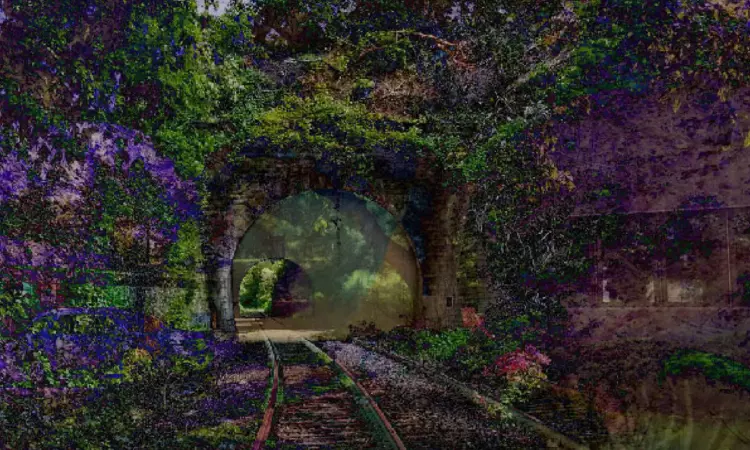Reshaping The Canvas: The Thaler Echo
Ebad Ur Rahman
31 Aug 2023 5:01 PM IST

A Recent Entrance to Paradise, Creativity Machine – Stephen Thaler.
In a recent legal development, the United States District Court for the District of Columbia adjudicated upon a pressing question at the crossroads of Artificial Intelligence (“AI”) innovation and Copyright Law. The case, Stephen Thaler v. Shira Perlmutter, Register of Copyrights and Director of the United States Copyright Office, et al.[1] (“Thaler”), has gained additional significance due to its occurrence amidst an ongoing strike by Hollywood workers, bringing to the forefront not only the intricacies of AI-generated creations but also the broader dynamics of the entertainment industry.
The case involves plaintiff Stephen Thaler’s attempt to register a piece of visual art titled A Recent Entrance to Paradise, generated by a computer system he calls the Creativity Machine for copyright protection. He asserted that the said computer system was the author of the work and sought to claim copyright ownership as the owner of the machine. The United States Copyright Office denied the application on the grounds that the work lacked human authorship, a prerequisite for copyright protection. Both parties submitted motions for summary judgment, requiring the Court to embark on a meticulous exploration of the key legal question: Can AI-generated works, devoid of any human contribution, be eligible for the safeguard of copyright protection?
While the legal matter itself is of profound importance, it is worth noting that this case unfolds against the backdrop of a labor strike. This strike, initiated by members of various entertainment guilds and unions, has brought film and television production to a standstill, underscoring the indispensable role of human creators in the entertainment industry. The strike’s demands for fair wages, reasonable working conditions, and a greater say in creative decision-making mirror the very essence of the copyright debate – the recognition and protection of human creative contributions.
While deciding the claim of the Plaintiff for copyright registration to be granted to an artwork crafted by an AI system, the Court meticulously delved into the crux of the matter by analyzing the Copyright Act of 1976, which extends protection to original works of authorship. The central question was whether the definition of author could encompass non-human entities. The Court’s opinion journeyed through the historical evolution of Copyright Law, shedding light on its adaptability in the face of technological progress. However, it underscores that this adaptability has always been anchored in the bedrock of human creativity. The judgment also referred to key cases such as Sarony[2] and Mazer[3], wherein the Supreme Court of the United States had highlighted the indispensability of human creative input as the core of authorship. Furthermore, the Court emphasized the fact that the term author itself has conventionally and inherently been linked to human creators, a perspective that is strengthened by well-established legal precedent.
Despite acknowledging the symbiotic relationship between AI and creativity, the Court maintained that the present case concerned a work autonomously produced by a machine without human intervention. Notably, even Stephen Thaler, the Plaintiff, confirmed the absence of human involvement in the creative process. Considering these factors, the Court ultimately upheld the Copyright Office’s denial of copyright registration. The Court asserted that the lack of human authorship renders the work ineligible for copyright protection. This decision has effectively cemented the perspective that works entirely generated by non-human agents, even if those agents are AI-powered, do not meet the criteria for copyright protection as outlined in the existing legal framework.
This verdict comes at a juncture when AI-generated works have been gaining prominence and challenging conventional notions of creativity and authorship. It transcends the singular court battle and has now become a seminal marker in the ongoing dialogue about AI’s integration into human domains, raising pertinent questions about the coexistence of human creators and their AI counterparts. While the Court acknowledged the evolving landscape, it maintained that human creativity remains the cornerstone of copyright protection. The ruling also highlights the importance of legislative and policy adaptations to address the novel questions posed by AI-assisted creations, a sentiment regularly echoed by legal experts and scholars.
The Thaler case serves as a pivotal reference point as the entertainment industry grapples with AI’s transformative potential. It reminds us that copyright protection is deeply intertwined with human creativity and that, despite technological advancements, human contribution remains a cornerstone of creative expressions. As Hollywood’s workers rally for their creative rights, the Court’s memorandum opinion and the ongoing strike converge to shape a broader narrative about the evolving landscape of creativity, innovation, and the protection of artistic endeavors in a rapidly changing world.
The author is an Advocate practicing in the Supreme Court and also at Bombay High Court . Views are personal.


